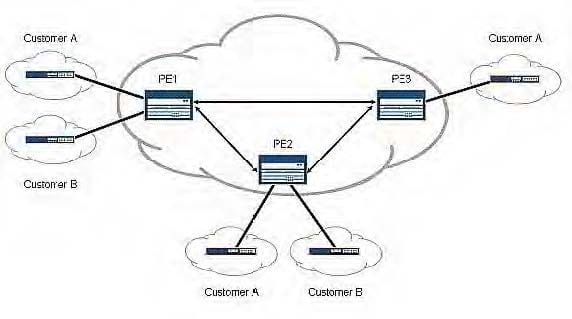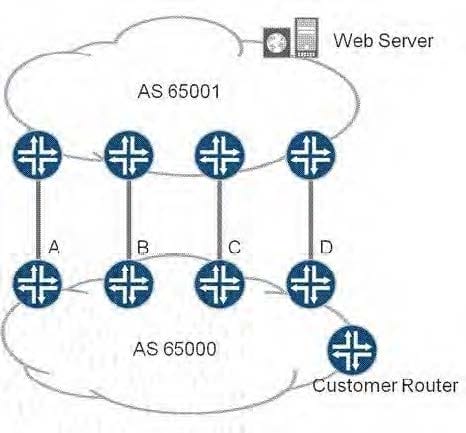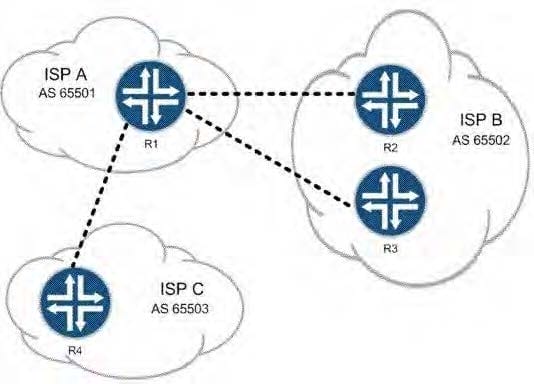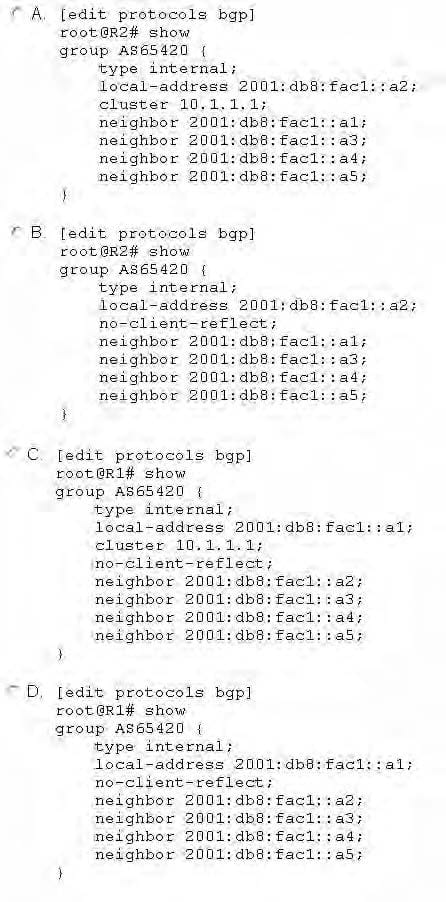Exam Details
Exam Code
:JN0-692Exam Name
:Service Provider Routing and Switching Support, ProfessionalCertification
:JNCIAVendor
:JuniperTotal Questions
:171 Q&AsLast Updated
:Apr 09, 2025
Juniper JNCIA JN0-692 Questions & Answers
-
Question 81:
You are asked to design a Layer 2 VPN service between service provider networks that needs Ethernet transport capabilities. The VPN should support two or three endpoints. Which Layer 2 VPN technology should you propose?
A. LDP-signaled VPLS
B. BGP-signaled VPLS, using the RFC 4448 Layer 2 frame format
C. LDP Layer 2 circuit, using the RFC 4448 Layer 2 frame format
D. BGP Layer 2 VPN
-
Question 82:
You just added route reflectors to your network and you find that all of your VPN routes are hidden on the route reflectors. What three solutions can you use to solve this? (Choose three.)
A. Use rib-groups to add IGP routes to inet.3 and/or inet6.3 on all of the client routers.
B. Add MPLS LSPs between the route reflectors and their client routers.
C. Apply a next-hop-self export policy on each of the route reflectors.
D. Use rib-groups to add IGP routes to inet.3 and/or inet6.3 on the route reflectors.
E. Add a static default route to inet.3 and/or inet6.3 on the route reflectors.
-
Question 83:
Click the Exhibit button.

Given the existing operational network shown in the exhibit, you now want to add a remote site for Customer B to the PE3 router. This change should not have an effect on the existing BGP sessions between the PE routers. Which Layer 3 VPN scaling mechanism allows PE3 to begin receiving Customer B routes?
A. route origin
B. route refresh
C. route reflection
D. route target filtering
-
Question 84:
You are a network administrator in charge of configuring CoS for your network. Your network includes a voice application with strict latency requirements, so that any packets delayed by more than 75 ms are effectively useless. When configuring the scheduler for this application, which feature ensures that you do not waste buffer space?
A. rate-limit
B. adaptive
C. latency-limit
D. temporal
-
Question 85:
Click the Exhibit button.

Router A: Local Pref 110, IGP Cost 1000 Router B: Local Pref 100, IGP Cost 200 Router C: Local Pref 110, IGP Cost 900 Router D: Local Pref 100, IGP Cost 1000 Through which link will traffic to the Web server leave your network (AS 65000) from the customer router?
You are the administrator of AS 65000. There are four links between your network (AS 65000) and your upstream provider (AS 65001). You have an import policy on all of your routers. The routing table on the customer router has four routes to the Web server as follows:
A. Router A
B. Router B
C. Router C
D. Router D
-
Question 86:
Click the Exhibit button.

You are an employee of ISP A. You must not allow traffic between ISP B and ISP C to cross your network, but customers of ISP B and ISP C must be able to reach your customers. Referring to the exhibit, which two actions would do this? (Choose two.)
A. Use communities to identify and filter routes.
B. Use policy to filter routes on AS number.
C. Use origin code to identify and filter routes.
D. Use the well-known no-advertise community.
-
Question 87:
Click the Exhibit button.
Customer A is complaining that CE1 and CE2 cannot form an OSPF adjacency across your LDP Layer 2
circuit. The physical topology of the network is CE1-PE1-P-PE2-CE2. PE1's loopback is 192.168.5.1, P's
loopback is 192.168.6.1, and PE2's loopback is 192.168.7.1.
Referring to the output in the exhibit, what is the problem?
A. mismatched virtual circuit ID values
B. mismatched interface encapsulations
C. incorrect PE-CE interface configuration
D. extended LDP neighbor not established
-
Question 88:
What does the Junos command advertise-inactive allow?
A. OSPF inactive routes to be advertised using BGP
B. inactive and hidden BGP routes to be redistributed into OSPF
C. the best BGP route to be re-advertised by BGP, even when it is not the best route
D. the second-best BGP route to be re-advertised by BGP, to back up the best BGP route
-
Question 89:
Click the Exhibit button.

The routers shown in the exhibit are connected in a full BGP mesh. R1 is the route reflector and R2 through R5 are clients. R3 should only receive one copy of all routes sent from R4.Which configuration is valid?

A. Option A
B. Option B
C. Option C
D. Option D
-
Question 90:
You manage an MPLS network. You are asked to classify traffic using the EXP bits from ingress to egress. What will allow you to accomplish this?
A. Configure explicit-null on the penultimate router.
B. Configure explicit-null on the egress router.
C. Configure implicit-null on the penultimate router.
D. Configure implicit-null on the egress router.
Related Exams:
Tips on How to Prepare for the Exams
Nowadays, the certification exams become more and more important and required by more and more enterprises when applying for a job. But how to prepare for the exam effectively? How to prepare for the exam in a short time with less efforts? How to get a ideal result and how to find the most reliable resources? Here on Vcedump.com, you will find all the answers. Vcedump.com provide not only Juniper exam questions, answers and explanations but also complete assistance on your exam preparation and certification application. If you are confused on your JN0-692 exam preparations and Juniper certification application, do not hesitate to visit our Vcedump.com to find your solutions here.